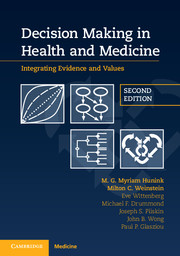Book contents
- Frontmatter
- Dedication
- Contents
- Foreword
- Foreword to the first edition (2001)
- Preface
- Acknowledgments
- list of Abbreviations
- About the authors
- 1 Elements of decision making in health care
- 2 Managing uncertainty
- 3 Choosing the best treatment
- 4 Valuing outcomes
- 5 Interpreting diagnostic information
- 6 Deciding when to test
- 7 Multiple test results
- 8 Finding and summarizing the evidence
- 9 Constrained resources
- 10 Recurring events
- 11 Estimation, calibration, and validation
- 12 Heterogeneity and uncertainty
- 13 Psychology of judgment and choice
- Index
- References
13 - Psychology of judgment and choice
Published online by Cambridge University Press: 05 October 2014
- Frontmatter
- Dedication
- Contents
- Foreword
- Foreword to the first edition (2001)
- Preface
- Acknowledgments
- list of Abbreviations
- About the authors
- 1 Elements of decision making in health care
- 2 Managing uncertainty
- 3 Choosing the best treatment
- 4 Valuing outcomes
- 5 Interpreting diagnostic information
- 6 Deciding when to test
- 7 Multiple test results
- 8 Finding and summarizing the evidence
- 9 Constrained resources
- 10 Recurring events
- 11 Estimation, calibration, and validation
- 12 Heterogeneity and uncertainty
- 13 Psychology of judgment and choice
- Index
- References
Summary
We are pawns in a game whose forces we largely fail to understand.
Dan ArielyIntroduction
This book has discussed a host of methods and approaches to analyzing decisions, to predicting alternate and optimal outcomes, and to applying quantitative and analytic approaches to understand and explain choices. Most of the chapters up until now have emphasized technical methods and are likely to have challenged and expanded your analytic skills. For this final chapter we will change gears to discuss the side of the brain that is commonly thought of as less analytical and more creative, the ‘right brain’ contribution to decision making. In this concluding chapter we will discuss the psychology underlying judgment and choice.
Think back for a moment to the example in Chapter 4 about genetic susceptibility for breast cancer. Here was the situation we were considering:
Genetic susceptibility for breast cancer
A 25-year-old woman has a strong family history of breast cancer, including a sister who developed the disease at age 35. Her sister has undergone genetic testing for cancer predisposition and has been found to carry a mutation in the BRCA1 breast cancer gene. The woman is concerned about her own risk of breast cancer and chooses to be tested. She is found to have the same mutation, and is told that her lifetime risk of developing breast cancer is approximately 65%. If she does nothing at all with this information, her chance of surviving to age 70 is 53% (compared with all women’s survival probability of 84%). She has a number of options open to her: (1) careful surveillance, including regular mammography and magnetic resonance imaging (MRI), which would increase her chance of surviving to age 70 to 59%; (2) prophylactic mastectomy – surgical removal of both breasts – which would increase her chance of surviving to age 70 to 66%; (3) prophylactic mastectomy now plus prophylactic oophorectomy – surgical removal of the ovaries – when she turns 40, which would increase her chance of surviving to age 70 to 79%. Both surgical options increase her chance of survival beyond that of surveillance, but carry some personal costs – mastectomy can affect sexual function and body image, oophorectomy causes early-onset menopause and prevents child bearing. Does the benefit of risk reduction with surgery outweigh the personal costs of these interventions?
- Type
- Chapter
- Information
- Decision Making in Health and MedicineIntegrating Evidence and Values, pp. 392 - 413Publisher: Cambridge University PressPrint publication year: 2014



